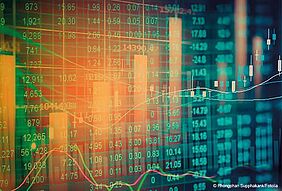Peter Teschke, capital market expert
Confidence prevails in the outlook for the economy and financial markets at the beginning of the year. The particularly highly contagious Omikron variant of the coronavirus is leading to high infection rates, but due to the predominantly mild course of the disease, easing steps are increasing worldwide and the economy sees light at the end of the pandemic tunnel. There is reasonable hope that by continuing to immunize the world's population, it will be possible to control the pandemic in large parts of the world in such a way that it can be phased out gradually. As a consequence, the bottlenecks in the supply chains should slowly disappear or at least be reduced. However, the shortage of semiconductors, which is making itself felt in many sectors such as auto manufacturers and mechanical engineering, is likely to prove particularly persistent and extend into the following year. The main reason is Europe's dependence on chip production sites in Asia and the USA. Supply bottlenecks, rising energy prices and fiscally stimulated excess demand in the USA are noticeably heating up inflation rates. For a long time, there were good reasons to assume that the Corona-induced inflation shock was "transitory", i.e. temporary. But in the USA and the UK in particular, labor markets are increasingly tight due to a lack of personnel, and wage pressure is building up. The danger of a wage-price spiral is increasing. In the USA, the FED announced last year that it was reversing its monetary and interest rate policy. It will stop its monthly bond purchases in March 2022 and has prepared the markets for several interest rate increases to the end of 2022 and beyond. The ECB intends to take a wait and see approach with regard to a key interest rate increase for the time being, although we do not rule out a first rate increase this year. The global economy is currently in the midst of an economic boom, which is slowly being deprived of support from internationally loose monetary and active fiscal policy. It is also to be expected that the low yields on the bond markets familiar from previous years will gradually rise, thus also increasing refinancing costs for companies. Geopolitical risks, such as the Russia-Ukraine or China-Taiwan conflicts, could also escalate at any time and cause severe damage to the global economy.
In this environment, we expect the global economy to grow by +4.3% in 2022. As in the previous year, this is above the long-term average (measured since 1980) of +3.5%. In this context, after a difficult Q1 in view of remaining Corona restrictions and high inflation weighing on real incomes, the economy should gain increasingly noticeable momentum in the further course of 2022. A look at the global data landscape points to a relatively synchronized positive development in the industrialized and emerging countries, but weakening compared with the previous year. In the emerging markets - especially China - lower growth impetus for the global economy must also be expected in 2022. For example, the Chinese government's rigorous crackdown with its "zero tolerance policy" during the Corona pandemic led to the closure of important ports for the export of goods. Regulatory interventions in China also continue to weigh on the technology and real estate sectors. Accordingly, we expect GDP growth in China to be only +4.8%. For the USA, we forecast GDP growth of +4.0% in 2022. Private consumption remains the mainstay of US GDP and has been growing steadily at around 3% p.a. for years. This is benefiting from the strong labor market, rising home prices and the good state of the US stock market. In the euro zone we expect GDP growth of +4.0%. The economy is expected to really take off in the second half of 2022, when the disruptions to international supply chains subside and the full order books can be worked off.
In this advanced phase of the business cycle, we expect to see increased pressure on profit margins at individual company level, following strong sales and profit growth last year, as many companies face higher production and input costs, e.g. for energy and personnel, in the wake of increased inflation rates. Companies with pricing power are coping better in this environment, as they can pass on price increases to their customers. By contrast, companies with little product differentiation will have problems passing on their increased costs.
Our forecasts for the end of 2022 for the segments US shares, European shares and German shares are therefore as follows: S&P 500 Index 5,000 points, Euro Stoxx 50 Index 4,600 points and DAX 16,500 points. Corporate earnings in most regions are expected to grow solidly in the higher single-digit percentage range, providing a good basis for rising share prices. Valuation levels for the international stock markets have already adjusted to the tougher central bank rhetoric with falling stock market prices in January and moved in the direction of their long-term averages. We consider a further noticeable P/E tightening unlikely, as we do not expect a global economic slowdown for the time being.
The bond asset class remains highly valued, despite the price losses at the beginning of the year. In the portfolio context, bonds continue to play an important role as part of diversification and for managing portfolio risk. We expect the 10-year Bund yield to rise further to +0.35% at year-end 2022, as inflation in the eurozone is expected to remain above the ECB's 2% target. As the ECB does not consider the current inflation drivers to be sustainable, it plans to reduce the volume of bond purchases starting in March 2022, but there are currently no plans to raise key interest rates. It can be assumed that the ECB does not want to impose a larger increase in yields on the highly indebted countries in the euro area. However, discussions about interest rate rises are likely to become increasingly intense. For 10-year US Treasuries, we also expect an increase to 2.20%. Within the bond segment, we consider higher-yield spread products such as high-yield bonds from Europe and also from the USA to be more attractive than government bonds. The expected good economic development should keep high yield spreads stable. The comparatively lower duration of the HY segment also buffers to a certain extent larger yield increases in the government bond segment. In this environment, we expect Global High Yield bond default rates to remain low in 2022, between 2%-3%. For 2022, we expect continued USD strength and forecast a EUR/USD of 1.12 at year-end, especially against the backdrop of diverging monetary and interest rate policies on this and the other side of the Atlantic.
This document has been prepared with the greatest possible care. For market assessments or benchmark information, the bank obtains data or information from sources that it considers to be reliable. The bank cannot guarantee the accuracy, timeliness and completeness of this data or information.
All information is provided for the purpose of fulfilling the asset manager's reporting obligations or for information purposes and to support the investor's own responsible investment decision. This document does not constitute investment advice or an offer for investment advice. It is not a substitute for individual investor and investment advice and does not contain any specific handling or investment recommendation. This document does not claim to be comprehensive or to contain all the information that an investor may require for his investment decisions. Historical observations or past performance are not a reliable indicator of future developments.
Only the contractual documents provided to the customer, in particular the terms and conditions and sales documents, are legally binding for the content of a contractual relationship between the customer and Fondsdepot Bank GmbH.



